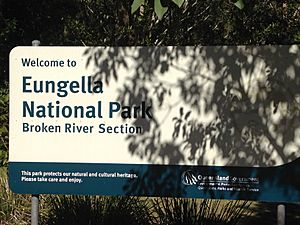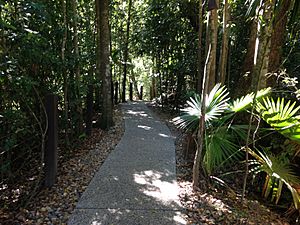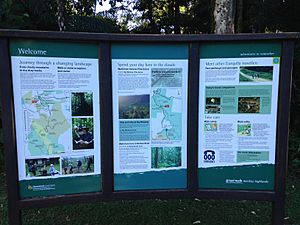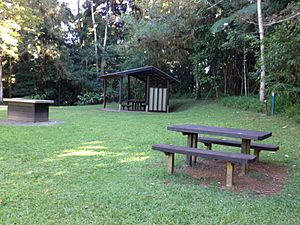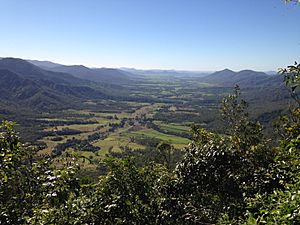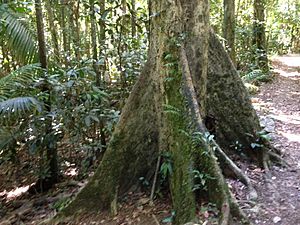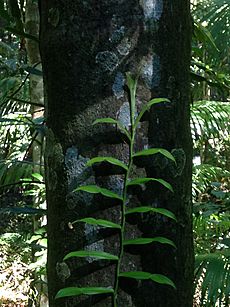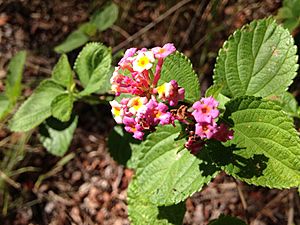Eungella facts for kids
Quick facts for kids Eungella National ParkQueensland |
|
|---|---|
|
IUCN Category II (National Park)
|
|

Araluen Falls in Eungella National Park
|
|
| Nearest town or city | Mackay |
| Established | 1941 |
| Area | 517 km2 (199.6 sq mi) |
| Managing authorities | Queensland Parks and Wildlife Service |
| Website | Eungella National Park |
| See also | Protected areas of Queensland |
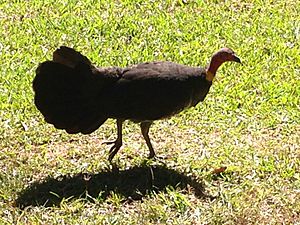
Eungella National Park is a special place in Queensland, Australia. It is about 80 kilometers (50 miles) west of Mackay. The name "Eungella" means "Land of the clouds" in the local Aboriginal language. This is a great name because the park often has clouds around it!
The park is famous for having the longest continuous stretch of subtropical rainforest in Australia. It is also well-known for its amazing wildlife, especially platypuses. The park helps protect many unique plants and animals that live only in this area.
Contents
What Makes Eungella Special?
Eungella National Park is located on a high area called the Clarke Range. This area rises to over 1,200 meters (3,900 feet) high. The park protects about half of the rainforest that was here before European settlement. Much of the original rainforest was cut down for timber.
The rainforests here are very important. They are like an isolated island of green in Australia. You can find tall eucalypt trees and hoop pines growing here.
Park History and Climate
Eungella National Park was first created in 1941. It has grown since then and now covers about 52,900 hectares (130,700 acres).
As its name suggests, Eungella gets a lot of rain, about 2,240 millimeters (88 inches) each year. The temperature in the park is usually about five degrees Celsius (nine degrees Fahrenheit) cooler than the areas around it. This makes it a pleasant place to visit.
Unique Animals and Plants
Eungella National Park is a hotspot for unique species. This means many plants and animals found here live nowhere else in the world! Scientists believe this area was a safe place for rainforest species during drier times in the past.
Some of the special animals found here include a unique leaf-tailed gecko, a spiny crayfish, a skink, and three kinds of frogs.
Amazing Plants of Eungella
The park is home to many types of plants, including different kinds of fungi, mosses, conifers, and ferns. The rainforests here are very sensitive to fire.
- Trees: The Elaeocarpus largiflorens is a rainforest tree that can grow up to 30 meters (98 feet) tall. Its fruits are eaten by many animals. The Eungella hairy daisy is a rare shrub found only in this area. Another rare tree, Omphalea celata, was discovered in 1994 and is a host plant for the zodiac moth.
- Ferns: The giant fern (Angiopteris evecta) is found in only a few places in Queensland, including Eungella. It needs a lot of water and humidity to grow its huge fronds. Another rare fern, Dryopteris sparsa, also lives here.
Wildlife of Eungella
Over 175 different kinds of mammals, reptiles, birds, and amphibians have been seen in the park.
Birds of the Rainforest
There are 111 bird species recorded in Eungella National Park.
- Eungella Honeyeater: This bird is found only in the highland rainforests of the Clarke Range. It was only discovered in 1975, making it the most recently described Australian bird species!
- Other Birds: You might also spot the red-necked crake, the buff-breasted paradise kingfisher, or the white-browed robin. The regent bowerbird and the glossy black cockatoo are also found here, reaching their northern limit in the park. Australian swiftlets breed in caves in the area.
Frogs and Their Challenges
Sixteen different kinds of frogs live in the park. Sadly, frogs around the world are facing many threats. A serious disease caused by a chytrid fungus is harming rainforest frogs in eastern Australia.
Eungella National Park is one of the most important places for unique frogs.
- Eungella Dayfrog: This frog used to be more common but its numbers have dropped. It is now considered endangered. This frog is special because it uses body language, like hops and arm movements, to talk to other frogs. This might be because the noisy mountain streams make it hard to hear calls.
- Eungella Tinkerfrog: This frog is considered "near threatened." It is hard to find and faces threats from things like farm animals, cane toads, and the chytrid fungus.
- Northern Gastric Brooding Frog: This amazing frog was discovered in 1984 but has not been seen since 1985. It is believed to be extinct. This frog was one of only two species in the world known to raise its young in its stomach! The mother would swallow her eggs and then "give birth" through her mouth.
Mammals of the Park
Twenty-eight mammal species have been recorded in the park, including several types of bats.
- Platypus: You can often see platypuses at the viewing platform at Broken River. Platypuses are unique mammals that use electric signals to find their food underwater. They have thick fur, webbed feet, and a flat tail, making them excellent swimmers. They store food in their cheek pouches and eat it when they come to the surface. Sometimes, azure kingfishers watch platypuses to catch fish that the platypuses disturb.
Reptiles of Eungella
Twenty species of reptiles live in the park.
- Geckos and Skinks: Three types of leaf-tailed geckos live here, with one found only in the Clarke Range. Two new types of snakes were recently discovered and are believed to live only in the Eungella area. The orange-sided rainforest skink is also unique to this area.
Insects of the Rainforest
Eungella National Park is home to several unique or rare insect species. Scientists have found many types of flies here, especially near streams and waterfalls. The Drosophila birchii fly is found only in warm, wet rainforests between New Guinea and Eungella.
You can also find the Phricta zwicka katydid and the Protochauliodes eungella megalopteran, which are known only from this area. Two new species of dragonflies were also found here. A survey in 1993 found 37 types of butterflies in the park.
Crustaceans
The Eungella spiny crayfish is unique to the creeks in the Clarke Range. It is critically endangered because it lives in a small area and is threatened by introduced animals like feral pigs, red foxes, feral cats, and cane toads. It is also at risk from climate change.
Threats to the Park
The amazing plants and animals of Eungella National Park face several threats. These include parts of their habitat being separated, the effects of introduced species, fires, and human activities.
Pest Plants and Animals
Many introduced animals live in the park, such as cane toads, red foxes, feral cats, rabbits, black rats, house mouses, and feral pigs.
- Feral Pigs: Pigs dig up the ground, which helps weeds spread. They also harm native plants and animals and can carry diseases. A disease called cinnamon fungus has been found in the Clarke Range, causing many rainforest trees to die.
- Predators: Cats, foxes, and feral dogs hunt native animals. Cats are known to prey on many bird, mammal, reptile, and amphibian species. Foxes hunt smaller mammals and birds. Feral dogs can hunt larger animals like wallabies. Roads and broken habitats can make it easier for these predators to reach native animals.
Weeds like lantana, blue morning glory, and red Natal grass are common along roadsides and disturbed areas. Lantana is a serious weed in Queensland. Other weeds in the park can easily catch fire, which is a big problem for the rainforest.
Fire in the Rainforest
Fire is a major threat to the rainforests of Eungella National Park. Rainforests do not need fire to grow. Fires can break the rainforest into smaller pieces, making it harder for plants and animals to survive. Fires can also change the types of plants and animals that live there and reduce important habitats like fallen logs and hollow trees.
Benefits of the Park
National parks like Eungella are created to protect nature. But they also bring economic benefits, especially to local towns. They create jobs and bring money from visitors. In 2001, visitors to Eungella National Park spent an estimated $10.9 million in the local area!
Visitor Facilities
- Camping: You can camp at Fern Flat campground, but you have to walk to get there.
- Picnic Area: The Broken River picnic area has facilities for day visitors.
- Walking Tracks: There are over 20 kilometers (12 miles) of walking tracks, some with beautiful views.
- Platypus Viewing: A special platform at Broken River is a great spot to see platypuses, eels, and turtles.



